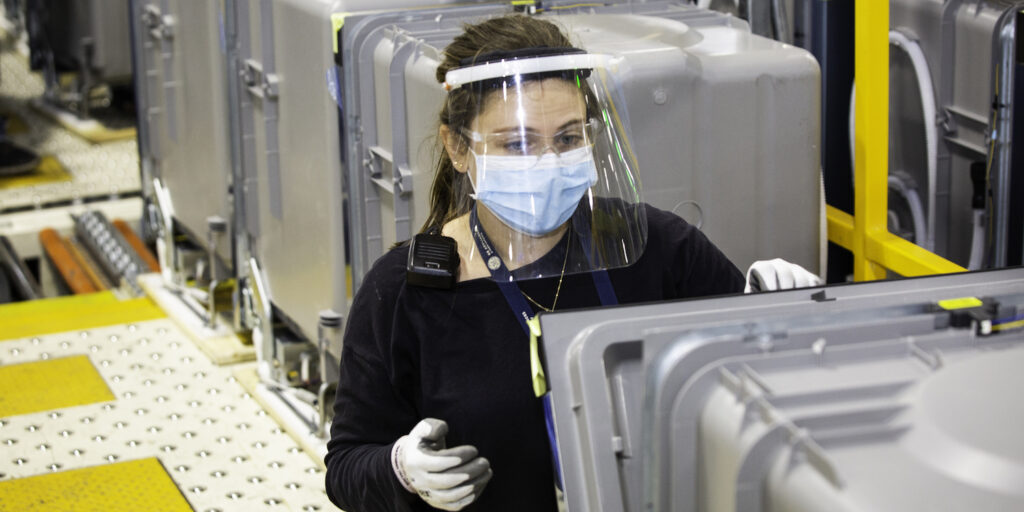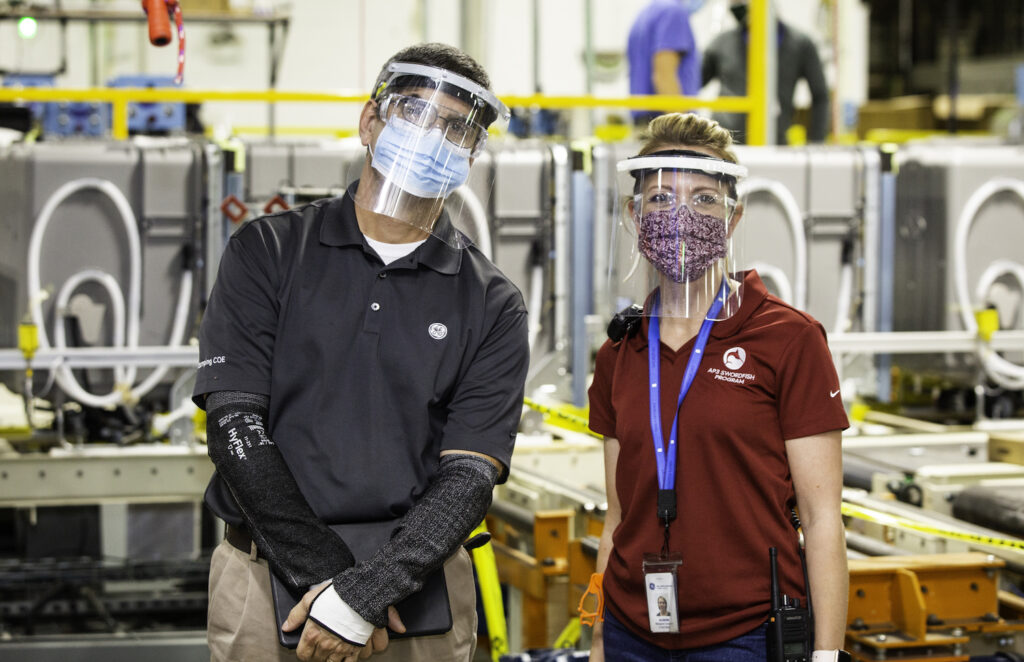Leveraging Lean to Create a New Product … and Process
Apr 28, 2023

INTERVIEW – In 2020, GE Appliances had to stand up a brand-new assembly process for a new dishwasher. The leader responsible for the program explains how LPPD helped them to get it right.
Interviewee: Alison Seward, Executive Director, Manufacturing Quality, GE Appliances
Roberto Priolo: In 2020, you ran a very successful project to stand up a production system and launch a new product at GE Appliances. Can you give us some context?
Alison Seward: I led an $80 million investment in our dishwasher product line, which is part of our kitchen cleanup business. We weren’t only developing a new dishwasher, but we also had to design and stand up a new assembly process. Since we were installing all of this into a factory that was already running production, we often joked that it was like changing the tires on your car while driving it down the road. As if that weren’t challenging enough, our launch date was November 2020, which means we had to do a lot of our equipment try-offs and installation during the worst months of the pandemic.
RP: What was your first step?
AS: One of the first things I did when I came into the project was restructuring how the team worked. We were very focused on our functional silos – design, quality, the commercial team, etc. Their work was very segregated. Going into this challenge, we had to take a different approach. So, I rearranged the team, physically. I asked people to move their desks and we relayed out the entire office. It was an unpopular move at first, but it was important that we disrupted the status quo.
I knew that to be successful, we’d need individuals to think outside of their functional areas. Of course, we needed the depth of their functional expertise, but we also needed them to have consideration for how their work impacted the greater project. Silos aren’t bad per se, but you can’t get stuck in them. You’ve got to be able to work outside of them, as well.
RP: You mention the decision to move people wasn’t popular. How did you navigate that transition?
AS: The team was fantastic in trying the new system, but it required a lot of heavy coaching and mentoring early on because it was a different process and different principles. It wasn’t necessarily that people were resistant, it was just that the system was new to them. It is natural for us human beings to resist change at first, so it did take a lot of energy and effort early on to transition the team and to train them in a different way of working.
I had great support from all the functional leaders in the product line, who were on board with the change. I really want to give huge credit to the team, who followed along with all my crazy ideas and jumped on board with it and really helped to make it work. Ultimately, they understood the challenge and why I was suggesting the change.

Alison with Plant Manager Doug Wichmann
RP: For the team involved in this project, was this the first exposure to LPPD principles and practices?
AS: For most of them, it was. We had done a lot of LPPD work around the different product groups, but it hadn’t really hit dishwasher, or hadn’t in a long time anyway. A lot of people in the team weren’t familiar with it. We provided a lot of training and other development opportunities to close that gap. For instance, I brought my design manager along with me at one of our LPPD learning partner sessions, to see how we could effectively teach people these ideas. I also arranged training with my team with John Drogosz from Lean Enterprise Institute, to bring somebody else in to talk about these principles instead of just me.
RP: What were the key milestones in the process of installing the new system?
AS: We started by really understanding the work. Everybody on the program team went out to our existing assembly lines and worked jobs there. We were strategic about where we placed people, of course. For example, our advanced manufacturing engineers, the people who design our equipment, were asked to go do some of the most physically challenging jobs, in the hope they would come up with ideas of how to do them better on the new line. So, we really started everybody out with that deep understanding of what the work was on the line. We coupled that with some basic training on standardized work for everybody on the team, so we could have conversations about the more technical aspects of lean.
From there, it was a very iterative process of looking at the layout from an equipment and work standpoint. We were lucky that seven of our team leaders, who were part of our hourly workforce, would be the team leaders on the new assembly line when it launched. We had them embedded in the program about a year and a half ahead of time, and they were responsible for helping us understand how the work was going to be laid out on the line. We could then couple that with the equipment layout. It was a constant iterative process to find a common solution where we had good equipment layout and a good work structure for the employees.
RP: When they think of LPPD, most people think about product development. But there is the other part of it, which is the design of the process. In your experience, what are the challenges inherent to the process development part?
AS: When the process is new, you don’t know what you don’t know, and that can be dangerous. For this dishwasher project, we built a mock assembly line section (we called it our dojo), with different conveyors that we could move in and out to simulate different areas of the line. We could speed them up, we could slow them down. We made fixtures out of Styrofoam sometimes. Basically, we tried things out (things can be look good on paper or in your mind, but until you try them out you don’t know). With those experiments, we learned some harsh lessons. When a configuration didn’t work, we had to go back and try again. The important thing was to learn what didn’t work when we were using Styrofoam and 3D printed parts as opposed to when we had steel on the floor and parts off of production tooling. We pushed to find issues early on. Really, this is the key advantage of LPPD over traditional produce and process development: you are going to find the problems eventually; but it is much better to find them when they don’t cost you a ton of rework and money.

RP: You configured the assembly line like a fishbone. Can you explain what that looks like?
AS: The different bones represented different parts of the product – the tub, the door rack, and so on – and they fed into main process, represented by the backbone of the fish. We structured the teams around these “bones”, so they would have autonomy over a lot of trade-offs within their fishbone area, so long as it didn’t ripple out to another group.
RP: What LPPD techniques and tools proved most useful in this project?
AS: We had quite a few. I already mentioned the mock-ups, which were very important when it came to designing the new process. We also had an Obeya, which was a super important piece of the puzzle for the team. All the relevant information was up on the walls, and anyone could always access it at any time. Our program leadership sat in the Obeya, too, making them always available to the team. Really, the Obeya was critical in connecting all the other LPPD practices we relied on.
We had a daily stand-up meeting with the entire program team, lasting 30 minutes or less. This really set the expectation for the day. On Mondays, we reviewed the schedule, using a wall that worked as a to-do list for our team, telling them what had to happen by when and who was responsible for it (it was color coded, too, making it very visual).
On Wednesdays, we did PDCA with our fishbone teams. For any problem that was flagged up, we asked people to suggest a solution. During the meeting, teams would take turns talking about the big items they were working on or the problems they were trying to solve, asking for help whenever they needed it.
Finally, on Fridays, we made decisions with our “decision diamonds” system. A few months into the program, we realized that we were good at tracking individual tasks but struggled to know whether we were on track or not. So, we took a step back and started to think about the critical decisions we needed to make in order to move forward. The number of decisions to be made decreased as we went on and moved into the execution phase, but at the beginning it was surprising how many we had to make (especially with the pandemic throwing new challenges at us all the time).
On Tuesdays and Thursdays, the topics of the meeting changed based on where we were in the program cycle.

RP: What results were you able to achieve?
AS: First, we stayed within schedule, even with the pandemic, which is amazing (for the appliance industry, getting products out before Black Friday is incredibly important). We were able to hit our product cost targets, but also our sales goals in terms of what we wanted to sell the product for. With our capex expenditure, we stayed within our budget of $80 million. We have also seen an improvement in our star ratings, which spoke to the customer’s experience with the product. Finally, we had a sold-out assembly line, having started with one shift, and added two more since.
This was quite the project. There is no doubt that what made it possible for us to launch successfully was having LPPD principles and a structure in place before the pandemic hit.
THE INTERVIEWEE

Alison Seward is Executive Director, Manufacturing Quality, GE Appliances.
Original Article: https://planet-lean.com/leveraging-lean-to-create-a-new-product-and-process/
Stay In Touch.
Subscribe to our newsletter and exclusive Leadership content.
We respect your privacy and won’t spam your inbox
